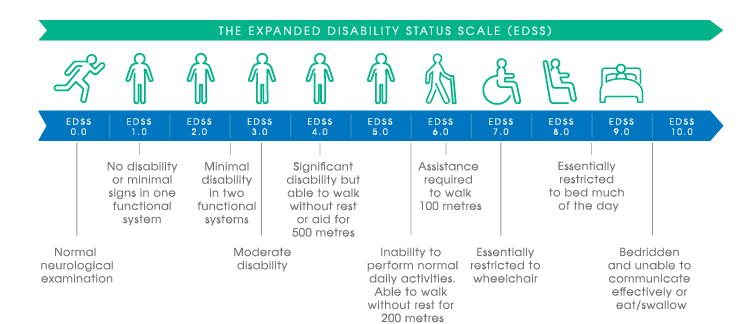Monitoring MS Symptoms

You’ll know better than anyone that the physical symptoms of multiple sclerosis (MS) can have a huge impact on your day-to-day life. When we talk about physical MS symptoms, we mean symptoms other than emotional problems or problems with cognition (thinking and memory). You can find some examples of physical symptoms you may experience in our MS Symptoms: Explore the interactive body article. Your doctor or MS nurse will want to keep track of how these symptoms are changing over time, using this information to decide if they need to suggest new ways to manage your MS, such as a treatment to slow the progression of your MS or to treat your symptoms.
- It’s important to have regular appointments with your doctor or MS nurse so they can keep track of your symptoms, to check if they are getting any worse
- As well as checking what’s going on in your brain, this is a helpful way to see how well your treatment is working
- Your doctor or MS nurse will ask about your daily life, how you feel and whether you’ve been experiencing any symptoms. Be honest – don’t be scared to say how you’re really feeling and try to openly discuss any concerns you might have, even if they don’t come up naturally in conversation
- They will also examine your reflexes and how well you’re able to move, speak, see, think, as well as how you feel
- Always remember – you’re the true MS expert and you’re a vital part of these appointments
Some people living with MS might have trouble walking due to balance problems, muscle weakness or tremors. These symptoms might come and go, but over time, they may gradually get worse. Your doctor or MS nurse may want to keep track of these problems to see if they are getting any worse and to help them to find out if your treatment is working for you.
The way they do this is by measuring and recording your mobility problems. The most common scale used by doctors or MS nurses is called the Expanded Disability Status Scale (EDSS), and it’s often used to assess how your MS is progressing by measuring your ability to do certain things, for example if you’re able to walk a certain distance. Your doctor or MS nurse may give you a physical examination and ask you questions about how you’re doing and what you’re able to do.
The EDSS is made up of a scale which goes up from 0 to 10. A score of 0 indicates healthy, normal functioning while a higher score reflects increasing impairments and disability:

Although the scale can look a little worrying as it includes all levels of disability, with appropriate treatment most people will never reach the higher scores associated with advanced multiple sclerosis.
It’s very likely that your doctor or MS nurse will be tracking your EDSS score, but you can also calculate, track and understand your own EDSS score in less than 10 minutes with this handy online tool.
The way in which the EDSS scale is currently used often means that it mostly focuses on disability in the lower limbs. However, there’s a test called the 9-Hole Peg Test (9-HPT), which measures how well your upper limbs are working.
It works by testing how well you can use both your dominant and non-dominant hands to carry out a particular task. The test is quite simple and takes about 10 minutes. Your doctor or MS nurse will time how long it takes you to pick up 9 pegs, place them in 9 holes and then remove them again.
As with the EDSS your doctor or MS nurse will keep track of these scores to see how your symptoms are changing and will use them to assess how well MS is being managed.
Remember, no one knows how you’re feeling better than you do. However, it can be difficult to be aware of how your MS symptoms are changing over time, or even throughout the day. That’s why it’s a good idea to keep a note of your symptoms, as this will help you and your doctor or MS nurse monitor your MS more closely. It can be a good idea to note down when you are experiencing symptoms and anything that could be causing them, such as if you are taking any treatments. This can help your doctor or MS nurse to work out if your symptoms are due to your multiple sclerosis, your treatment, or something else. You can then work together to ensure you’re managing your MS in the best way possible for you.
Read our Understanding side effects and symptoms article to improve conversations with your neurologist.
- Giovannoni G et al. 2017. Brain health: time matters in multiple sclerosis. Available at: https://www.msbrainhealth.org/report. Last accessed: October 2017.
- Neurological exam. Available at: https://multiplesclerosis.net/diagnosis/nerurological-exam/. Last accessed: October 2017.
- Expanded Disability Status Scale (EDSS). Available at: https://www.mstrust.org.uk/a-z/expanded-disability-status-scale-edss. Last accessed: October 2017.
- 9-Hole peg test (9-HPT). Available: http://www.nationalmssociety.org/For-Professionals/Researchers/Resources-for-Researchers/Clinical-Study-Measures/9-Hole-Peg-Test-(9-HPT). Last accessed: October 2017.
Related Items

Monitoring the brain in MS
Learn about how MS activity is monitored, specifically how MRI scanners are used to see what is going on in your brain.

MS Symptoms: The interactive body
Symptoms of MS, MS symptoms, problems with walking, mobility problems, muscle weakness, fatigue, emotional problems, mental MS symptoms, physical MS...
.jpg/jcr:content/Understanding%20MS%20(1).jpg 767w, /.imaging/webp/sanofi-platform/imgAutox300/dam/msonetoone-eu/Understanding-MS-(1).jpg/jcr:content/Understanding%20MS%20(1).jpg 1200w)
Understanding side effects and symptoms
Learn about the differences between side effects and symptoms and how to identify them.